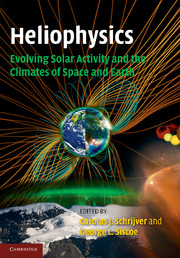Book contents
- Frontmatter
- Contents
- Preface
- 1 Interconnectedness in heliophysics
- 2 Long-term evolution of magnetic activity of Sun-like stars
- 3 Formation and early evolution of stars and protoplanetary disks
- 4 Planetary habitability on astronomical time scales
- 5 Solar internal flows and dynamo action
- 6 Modeling solar and stellar dynamos
- 7 Planetary fields and dynamos
- 8 The structure and evolution of the three-dimensional solar wind
- 9 The heliosphere and cosmic rays
- 10 Solar spectral irradiance: measurements and models
- 11 Astrophysical influences on planetary climate systems
- 12 Assessing the Sun–climate relationship in paleoclimate records
- 13 Terrestrial ionospheres
- 14 Long-term evolution of the geospace climate
- 15 Waves and transport processes in atmospheres and oceans
- 16 Solar variability, climate, and atmospheric photochemistry
- Appendix I Authors and editors
- List of illustrations
- List of tables
- References
- Index
- Plates
9 - The heliosphere and cosmic rays
Published online by Cambridge University Press: 05 April 2013
- Frontmatter
- Contents
- Preface
- 1 Interconnectedness in heliophysics
- 2 Long-term evolution of magnetic activity of Sun-like stars
- 3 Formation and early evolution of stars and protoplanetary disks
- 4 Planetary habitability on astronomical time scales
- 5 Solar internal flows and dynamo action
- 6 Modeling solar and stellar dynamos
- 7 Planetary fields and dynamos
- 8 The structure and evolution of the three-dimensional solar wind
- 9 The heliosphere and cosmic rays
- 10 Solar spectral irradiance: measurements and models
- 11 Astrophysical influences on planetary climate systems
- 12 Assessing the Sun–climate relationship in paleoclimate records
- 13 Terrestrial ionospheres
- 14 Long-term evolution of the geospace climate
- 15 Waves and transport processes in atmospheres and oceans
- 16 Solar variability, climate, and atmospheric photochemistry
- Appendix I Authors and editors
- List of illustrations
- List of tables
- References
- Index
- Plates
Summary
Introduction
The heliosphere is a vast spheroidal cavity in the local interstellar plasma, some 150–200 AU in size, created by a supersonic flow of plasma called the solar wind, which flows radially outward from the Sun in all directions (Fig. 9.1). The scale of the heliosphere is determined by both the solar atmosphere and the pressure of the surrounding interstellar plasma and magnetic field. Far enough from the Sun the solar wind is spread over such a large volume that it can no longer push back the interstellar plasma. Because the wind is flowing out much faster than waves can propagate inward, the solar wind flow ends at a s pheroidal shock wave, which is called the termination shock, where the supersonic flow changes suddenly to a subsonic outward flow.
The interstellar plasma is moving at about 26 km/s relative to the heliosphere, pushing it in on one side, as shown in Fig. 9.1. Beyond the termination shock, the solar plasma continues to flow outward, but it is deflected and eventually turns to flow in the same direction as the interstellar plasma, forming a large, trailing, heliospheric tail (see Vol. II, Fig. 7.1b). The interstellar medium also contains neutral atoms, and while these play a role in the interaction, they may be neglected in the lowest order.
Information
- Type
- Chapter
- Information
- Publisher: Cambridge University PressPrint publication year: 2010
Accessibility standard: Unknown
Why this information is here
This section outlines the accessibility features of this content - including support for screen readers, full keyboard navigation and high-contrast display options. This may not be relevant for you.Accessibility Information
- 1
- Cited by
